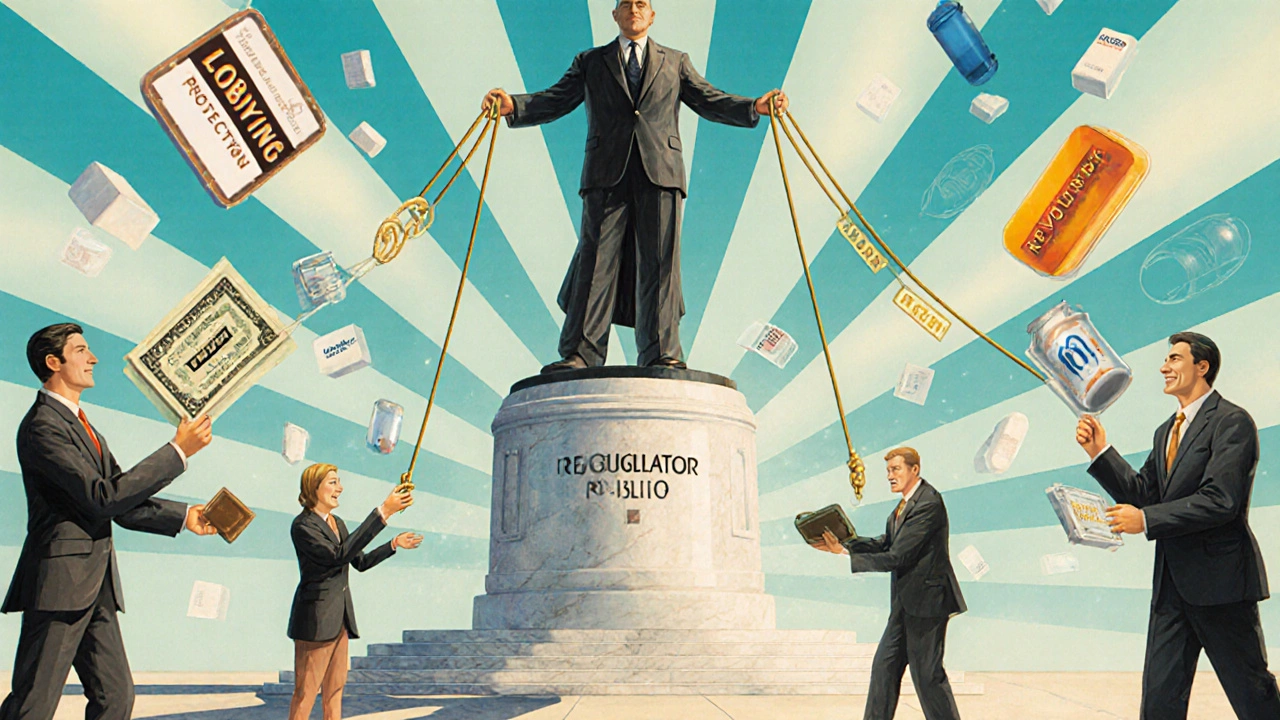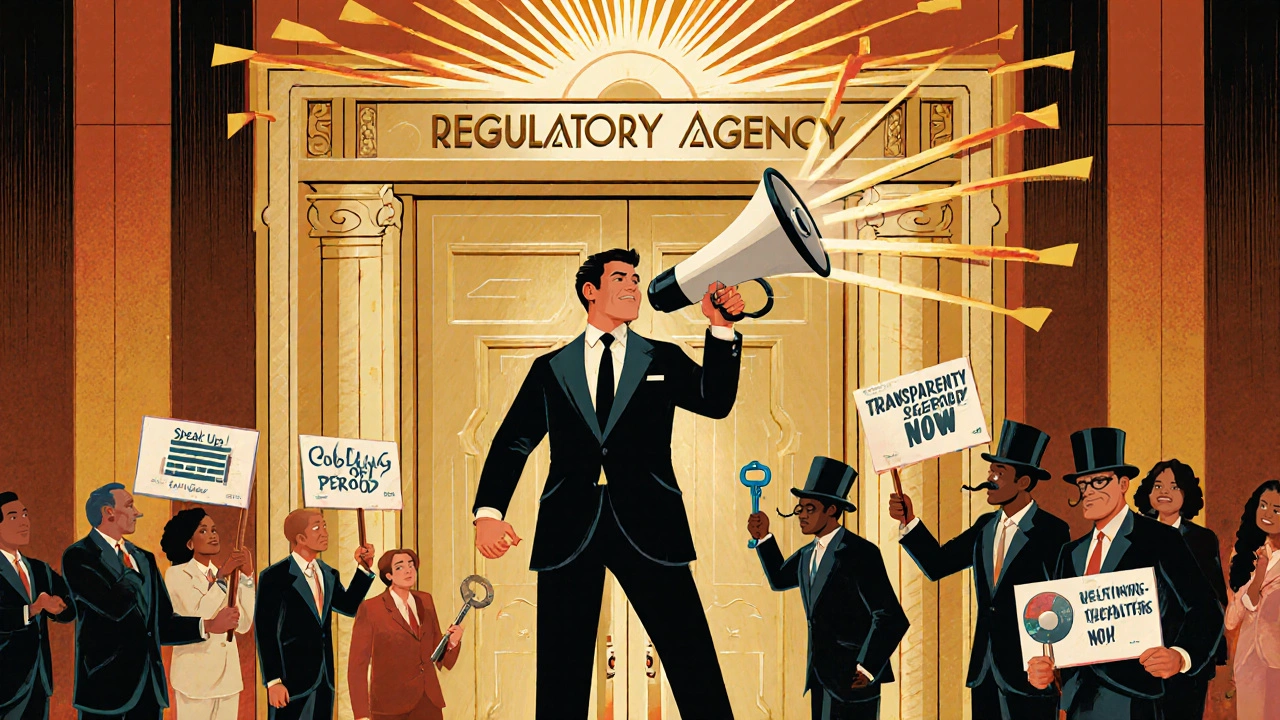Regulatory Capture: How Industry Influence Undermines Public Protection

Imagine a agency created to keep your food safe, your drugs pure, and your power bills fair. Now imagine that same agency spends more time talking to the companies it’s supposed to be policing than to the people it’s supposed to protect. That’s not a conspiracy theory. That’s regulatory capture.
Regulatory capture happens when the companies being regulated end up running the rules. Not through bribery alone - though that happens too - but through quieter, more systemic ways: former regulators joining the industry they once policed, agencies relying on industry data because they don’t have their own experts, or politicians fearing backlash if they crack down on powerful firms. It’s not about one bad apple. It’s about a whole system tilting toward those with the most to gain.
How It Starts: The Mechanics of Capture
Regulatory capture doesn’t happen overnight. It creeps in. The most common way is through the revolving door. Officials leave their government posts and land high-paying jobs at the very companies they used to oversee. In the U.S., 53% of senior Defense Department officials moved into the defense industry within a year of leaving government between 2008 and 2018. The same pattern shows up at the SEC, where 87% of top regulators had ties to Wall Street firms they were supposed to monitor before the 2008 financial crash.
Then there’s cultural capture. Regulators spend years working with industry insiders. They attend the same conferences, read the same reports, share the same jargon. Over time, they start thinking like the companies they regulate. They begin to see industry concerns as legitimate, even when those concerns hurt consumers. A regulator might say, “We can’t shut this down - it would hurt innovation.” But innovation that ignores safety isn’t innovation - it’s risk shifting.
And then there’s information asymmetry. Complex industries like pharmaceuticals, finance, or crypto don’t just have big budgets - they have deep technical knowledge. Regulators often don’t. So they rely on the industry to explain how things work. That sounds reasonable until you realize the industry is writing the textbook. In the case of the Boeing 737 MAX, the FAA delegated 96% of safety reviews to Boeing employees. Who was checking the checkers? No one.
Real-World Examples: When Rules Serve Profits
The U.S. sugar industry is a textbook case. For decades, the government has kept sugar prices artificially high through tariffs and quotas. Why? Because 4,318 sugar producers make billions in extra profit - while each American household pays about $33 a year more for sugar than they would on the open market. That’s $3.9 billion a year from consumers, mostly low-income families, going to a tiny group of corporations. The cost is spread thin across millions. The benefit is concentrated. That’s the perfect setup for capture.
In the UK, HM Revenue and Customs ran “Project Merlin” from 2012 to 2019. It gave 1,842 multinational corporations secret tax deals averaging £427 million each. Meanwhile, the public was told corporate tax rates were still at 19%. The truth? Many of these firms paid far less - sometimes nothing. The National Audit Office called it a “failure of enforcement.”
Energy regulators in the UK, like OFGEM, approved £17.8 billion in bill hikes between 2015 and 2020 to fund grid upgrades. But during that same period, energy companies maintained average profit margins of 11.2% - nearly double the 6.8% cap regulators had set. Citizens Advice Bureau found that while customers paid more, profits stayed high. The regulator didn’t push back. Why? Because the industry had the ear of the agency.

Why It’s So Hard to Stop
Public choice theory explains why capture thrives. Groups with concentrated interests - like a handful of sugar producers or a few big banks - have everything to gain from favorable rules. They’ll spend millions lobbying, hiring former regulators, and funding think tanks. Meanwhile, the cost is spread across millions of consumers. Who’s going to spend hours writing to their MP about sugar prices? No one. The public is distracted, busy, and doesn’t even know they’re being overcharged.
Industry lobbying spends 17.3 times more per person than consumer advocacy groups in OECD countries. In the U.S., industry political contributions outpace consumer group spending by 22.4 to 1. That’s not a fair fight. That’s a rigged game.
And when agencies are isolated from oversight - with no regular audits, no public hearings, no independent reviews - capture grows unchecked. The World Bank found that agencies with less than 30% congressional or parliamentary scrutiny were over four times more likely to be captured.
Who’s Affected? Everyone - But Not Equally
Regulatory capture doesn’t just mean higher prices. It means unsafe products, delayed enforcement, and eroded trust. After the 2008 crash, the SEC didn’t just miss warning signs - it had staff who were friends with the people they were supposed to investigate. In the pharmaceutical industry, former FDA officials who joined drug companies helped fast-track approvals for drugs with weaker evidence than what’s required in Europe. One Reddit user, who worked inside the system, said: “My former employer routinely got FDA approval for drugs with 60% weaker clinical evidence than required by EU regulators.”
Consumer trust is collapsing. Yelp reviews for financial services rate government protection at just 2.1 out of 5. On Twitter, 89% of tweets mentioning “regulatory capture” are negative. People aren’t just angry - they’re right to be.
The impact isn’t just economic. It’s democratic. When regulators stop serving the public, people stop believing in institutions. And when trust in government falls, democracy weakens.

What’s Being Done - And Why It’s Not Enough
There are fixes on the books. The U.S. Ethics in Government Act requires cooling-off periods before former officials can lobby. But 41% of violations go unpunished. The EU has a Transparency Register for lobbyists. Only 32% of big corporations comply. Training programs in Canada reduced industry meetings by 27% and boosted public input by 43%. That’s promising - but it’s a drop in the ocean.
Some places are trying bolder ideas. New Zealand’s independent Regulatory Standards Bill cut industry-preferred rules from 68% to 31% between 2016 and 2022. France’s citizen-led “Convention Citoyenne pour le Climat” reduced energy sector influence on climate policy by 52% by putting ordinary people in the room with lawmakers.
The U.S. Federal Trade Commission launched a “Regulatory Capture Initiative” in 2023, with a $23 million budget and a new Office of Regulatory Integrity. But will it last? History says reform is easy to start, hard to sustain. When industry power is this entrenched, change requires more than a new office - it requires public pressure.
What Can You Do?
You don’t need to be a policy expert to fight regulatory capture. Here’s what works:
- Ask questions. When a new rule is proposed, look up who’s lobbying for it. Who wrote it? Who benefits?
- Support watchdogs. Groups like Public Citizen, OpenSecrets, and the Center for Responsive Politics track industry influence. Donate. Share their reports.
- Speak up. Public comment periods aren’t just formalities. They’re your voice. If you’ve been hurt by a bad product, a high bill, or a delayed recall - say so. Regulators listen when they hear from real people.
- Vote for accountability. Support candidates who push for transparency, independent oversight, and closing the revolving door. Don’t just vote for who you like - vote for who won’t be bought.
Regulatory capture isn’t inevitable. It’s a choice - made by politicians, by regulators, by lobbyists, and by the public who stays silent. The system was built to protect you. But if you don’t defend it, someone else will take it over.
What is regulatory capture?
Regulatory capture occurs when government agencies meant to protect the public end up serving the interests of the industries they regulate. This happens through tactics like the revolving door, industry lobbying, reliance on industry-provided data, and cultural alignment - not always through outright corruption.
Is regulatory capture illegal?
Not always. Many forms of capture - like former regulators joining industry firms after a cooling-off period, or industry experts advising agencies - are legal. What’s illegal is bribery, fraud, or explicit quid pro quo deals. But the system is designed to allow influence, making capture hard to prove - and even harder to stop.
Which industries are most affected by regulatory capture?
The financial sector has the highest capture rate at 67%, followed by energy (58%) and pharmaceuticals (52%), according to the World Bank. These industries have high profits, complex regulations, and strong lobbying power. Sugar, tobacco, and defense are also classic cases where concentrated benefits and dispersed costs make capture easy.
Can regulatory capture be reversed?
Yes - but it takes sustained pressure. New Zealand reduced industry-influenced rules from 68% to 31% using independent oversight. France used citizen assemblies to cut energy sector influence by half. Canada’s training programs improved regulator independence. The key is transparency, public participation, and breaking the revolving door.
How does regulatory capture affect everyday people?
It costs you money, safety, and trust. You pay higher prices for sugar, energy, and drugs. You get slower recalls of dangerous products. You see banks and corporations get away with violations while ordinary people face fines. And over time, you lose faith that government works for you - not just for the powerful.
Regulatory capture isn’t a distant theory. It’s in your grocery bill, your electricity statement, and the drugs you take. The question isn’t whether it exists - it’s whether you’re ready to do something about it.

Lisa Detanna
November 23, 2025 AT 12:32Been thinking about this since I read the sugar tariff stats. I used to work in food policy and let me tell you - the lobbying meetings were more like industry retreats. Regulators showing up in branded hoodies, laughing about how "we all just want safe food" while quietly approving sweeteners that got banned in the EU. No one called it out because everyone was too busy getting their next job lined up.
It’s not corruption. It’s culture. And culture doesn’t get fixed with new laws - it gets fixed when people stop treating regulators like corporate interns.
Demi-Louise Brown
November 24, 2025 AT 09:44The structural incentives are misaligned. Regulators are underfunded. Industry is over-resourced. The revolving door isn’t a loophole - it’s the design.
Without independent oversight, transparency mandates, and real penalties for noncompliance, we’re just rearranging deck chairs on the Titanic.